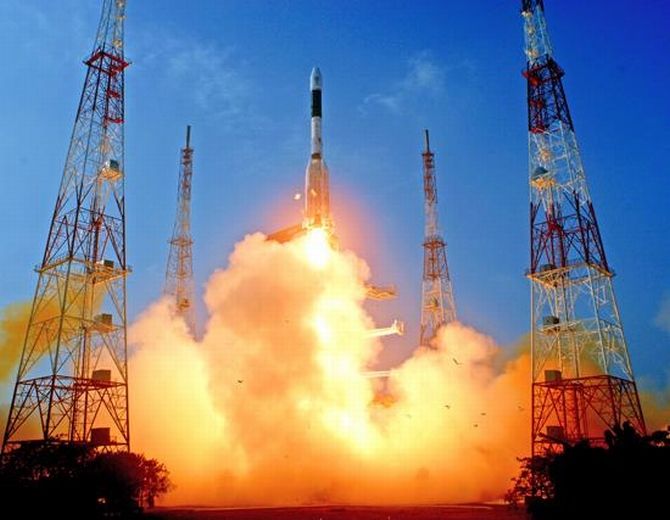‘We've shown we’re in a position to work with global agencies, for bringing in solutions that are relevant to global activities.’
‘There has been a lot of misinformation on that (Geospatial Bill) and we have also commented on it.’

Indian Space Research Organisation has shown noteworthy results in launching rockets and satellites to space on a shoestring budget. A S Kiran Kumar, the ISRO chairman, image, below, talks of what’s on and what lies ahead in an interview to Alnoor Peermohamed and Raghu Krishnan.
Where is the ISRO today? What are the plans in the coming decade?
We have focused on communication, navigation and earth observation capabilities in satellites. In all these areas, we’re limited by our capacity to realise and launch. Today, we have 35 satellites. If you see in terms of requirements, maybe I should have double this number operating at any given point of time, to meet our requirements. We have to build capacity and are increasing the number of launches of the Polar Satellite Launch Vehicle. We started with once in a few years, then a couple in a year. Till recently, we were 2-2.5 per year but we’ve already tried to make it sic-seven a year in terms of PSLV.
But, then, this increase cannot happen on its own. We need a supply chain capacity and the industry is trying to build more. We have to give emphasis and make sure that industry capacity grows and our own capacity, the number of launches, grows. In the Geosynchronous Satellite Launch Vehicle, we had issues; we have overcome that. We’ve launched two GSLV Mk-II and are planning that every two years, we will launch a Mark II. Then, Mark III this December and the next December we intend to complete that. In the PSLV, while we are using it for our own capacity, whatever is left, we’re augmenting and providing solutions for others. So, it has become a vehicle that is sought after when it comes to that.
So, while we are enabling and enhancing the capacity for our own use, we also have an opportunity to make it commercial. Towards that, we are discussing with industry on how to form a consortium or a mechanism where our capacity for launching can go up to maybe 12-18 a year. One is a consolidation phase and the other is capacity building to meet the growing demand.
 In this, where are we compared to global agencies?
In this, where are we compared to global agencies?
As things progress and there is more demand, you need to ensure -- today for example if you look at the cost of access to space, there are a lot of private entities that are getting into this space, whether it is in America or Europe. When they start operating, they will be looking at how the cost can be brought down. So now, these are also challenges to agencies like ours. Now they have to look at how they can survive in this environment, if you come and tell I will do in $2 million (Rs 13 crore) what they’re doing in $10 million (Rs 67 crore), after a couple of times, the government will ask why should I do it from your side? So all the government agencies also have to start looking at these scenarios which are happening.
A large number of smaller satellites are coming out, and they also require launch opportunities which others have not been able to provide and we have been able to provide. So you need to leverage that. But then you also need to make sure that you continue to improve your ability to provide solutions at a contemporary and competitive price. So that is where the reusable launch vehicle type of things come into the picture where you need to ensure that the cost of access to space comes down, so that you are able to be competitive in the coming days.
In addition to this, we also have our own science missions. You need to do these activities from another point of view as well -- you need to make sure of the capacity you are building in the country, unless you keep challenging them to do more and more difficult activities, their ability to visualise and find solutions to even our regular activities also gets continued.
You must have heard that you need to keep running to remain at the same place also, which means you have challenging assignments also.
Is this helping the ISRO get more collaborations?
As you keep improving your capabilities, others in the play want to come and join or leverage the international relationship so that cost of doing things for the global community also comes down. See, after we did our radar imaging satellite, Mars mission, the Chandrayaan mission, even the NASA (National Aeronautics and Space Administration) is ready to work with us for a mission.
So, we’re doing a NISAR mission in 2021. A few years before, they would not be willing to even consider any mission discussion with us. We've shown we’re in a position to work with global agencies, for bringing in solutions that are relevant to global activities. We have to ensure we are able to continuously build capacity, in the required numbers.
Where are we compared to SpaceX and all these companies?
There still is a shortage in capacity globally. It need not continue that way. This is where if cost of access is brought down significantly, they will also end up with a situation where if they’re able to meet all the demands, scale it up accordingly, they will capture that market.
If you are able to build on top of what we’ve built, PSLV commercialisation and all that, make it more and more attractive, there is a possibility that Indian industry can also gain in this global opportunity. That’s where we’re now trying to formulate -- we’re looking at the possibility of 2020, whether that Indian industry plus ISRO, whether they can launch the first (space) vehicle in 2020. Beyond that, they can not only provide satellite launches for us; they can also market outside.
This collaboration with the private sector -- the consortium will be a separate entity?
Those details we are trying to work out. Should it be a private company with a joint venture, say 51:49 or 50:50, like the BrahMos model, and other things.
Finally, we want in-the-country capacity, which can also help that entity market outside. Again, these are certain areas we still have to go through, whether there are any regulatory mechanisms because of launcher has multiple uses, what kind of protection has to be built. We have Godrej, we have L&T (Larsen and Tubro), we have HAL (Hindustan Aeronautics Limited)...many of the companies are already doing (work) for us. Now, they also want to know what kind of numbers are there. We're saying this is what is there; if you have the ability to market more, you can get more.
We already have Google talking about satellite-based internet services. Where are we as a country in providing such services?
Right now, OneWeb and all these guys are talking about building 900 satellites and launching it in the next three-four years to bring such a thing. This is a global service, you can say, which they will provide and we don’t have to compete with them.
We are still prioritising our capabilities for major requirements, whether for weather monitoring or earth observation. We also have a large number of applications which are growing massively. We have this programme called a space-based information system for decentralised planning, where the idea is to reach out to individual village panchayats and enabling them to plan activities and making them aware.
For example, we’re working on how to use India’s postmen to build a database. Like, if these postmen can monitor crops in the region and feed it into the database. Today, you have a national crop forecasting centre in Delhi and that provides a forecast before harvesting that utilises satellite imagery. We have identified 6-8,000 locations to do in situ observation. There are 150,000 post offices in India; even if one postman provides for a single location, that itself becomes a large number.
So we’re able to bring in communication, navigation, earth observation and then bring in ground-based crowd sourcing and linkages to do a huge number of applications.
You’ve spoken a lot about crowd sourcing, but there has been a lot of outrage about the Geospatial Bill.
There has been a lot of misinformation on that and we have also commented on it. What should be happening is, you should not be restricting the use of data for generating information. There are certain kinds of restrictions which you want to put. Talk about that and even there, put those data which you have to supply in a certain form, which will go through a vetting process. Otherwise what restriction you want to put, you cannot put it generally. If you take a picture and that becomes a restriction, you cannot do that.
In people’s minds, Google Maps are more well-known than Bhuvan (ISRO’s geo-portal). Why is that?
That is going to be there. If you see the number of people Google will be employing and the kind of activities they will be doing, it is very different from what we’re doing. Finally, it is a commercial entity; their interest is going to be to keep you hooked, it is a business. And, the number of people they will get to use will be huge, so the things they can do are different. But, with the information we’ve been able to collect over many years and the number of layers we’ve been able to build with Bhuvan, its use for specific activities is much more.
Obviously, the dissemination and making it known has its own timeline but now, with the kind of emphasis the governments are putting on usage, they are also realising that if they put something on Google, what is their security?











